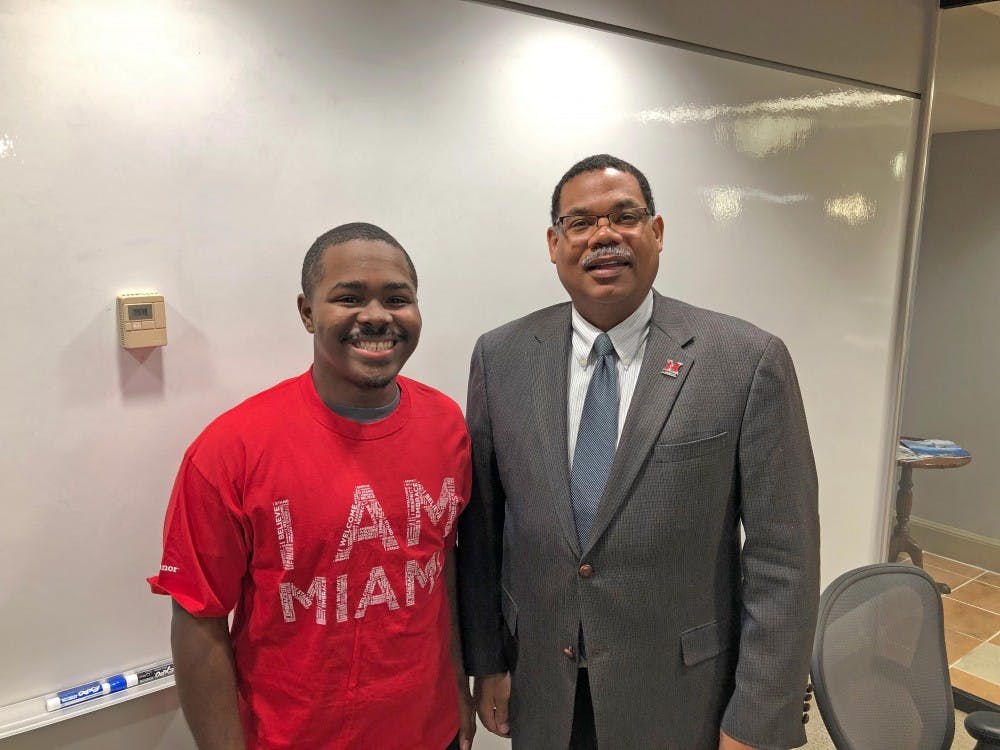Two weeks ago, hundreds of students, faculty and staff demanded action from Miami University President Greg Crawford to combat climate change.
One month ago, hundreds of students marched against white supremacy and gun violence.
Two years ago, Jaylen Perkins and dozens of other students in the Black Action Movement (BAM) 2.0 demanded action from the university on diversity and inclusion. Only after several demonstrations did they get a meeting with administrators.
But today, Perkins does not have to demand a seat in the rooms where decisions are made. He’s the student body president.
At first, though, he was not sure if he wanted to run.
“I think, ultimately, what did it for me was working on behalf of black students sophomore year with the Black Action Movement, and working with administration and seeing how willing they were to work with students,” Perkins said. “It helped me see how serving as an effective advocate can make such a big change.”
Perkins joins a list of only six other black men who have served as Miami’s student body president. The first came in the 1951-1952 academic year, when Wells Didlick served as the president of the Student-Faculty Council, the equivalent position at the time.
Perkins is not the only black student body president still walking Miami’s halls.
Randi Thomas, the director of Miami’s Office of Institutional Relations, also served as student body president during the 1987-1988 academic year.
The two men have near-identical resumes. Both served as president of the Black Student Action Association, resident assistants, members of Alpha Phi Alpha Fraternity and were active in advancing the issues of black students at Miami.
One of the major issues Thomas worked on was pushing the university to divest from companies that traded or operated in South Africa. At the time, South Africa still maintained its racial segregation and discrimination policy of apartheid.
“[T]o be able to have been in those leadership positions and see change, having contact with the administration, seeing what's possible, and then hearing from students the things that they would like to see changed and made better, [taking action] becomes somewhat natural,” Thomas said.
Enjoy what you're reading?
Signup for our newsletter
Through their experiences as student body president, both Perkins and Thomas found that the reality of working with administration differs from the perceptions they had in their activist roots.
“I'll say that one of the most important things to recognize and something that I keep getting reminded over and over again is that we're on the same team,” Perkins said. “When we win, they win and when we lose, they definitely still win. But, at the end of the day they want what’s best for students.”
His challenge is communicating to students that the university is, in fact, on their side, particularly in the face of continuing controversy around issues related to race, the most recent iteration coming in the form of a promotional music video, “From Now On,” that some say inaccurately portrays the diversity and culture on Miami’s campus.
“I'm a passionate believer that if you don't feel like your voices are being heard, you need to yell louder,” Perkins said. “I say that being from the student activist perspective, as somebody who felt like nobody was listening, and I felt like I didn't have anybody in that inside knowing exactly what was going on with our experiences.
“I just recognize that there's so much intentionality that is behind our administration, and those that are our faculty and staff,” he explained. “On a day-to-day basis, they're definitely trying to keep the students at the focal point. Whether or not it’s portrayed that way, whether or not that's accepted that way, that’s ultimately what I believe is being done by administration at all different levels.”
“It's not administration versus students; it's administration for students,” Perkins added.
Perkins said his role as Student Body President has changed his mindset from being a student activist to “what's best for the university, what's best for the students' perspective as well.”
Thomas said he has not shaken his activist mindset from his time as a student.
“President Perkins has to remind me that I’m administration and no longer a student activist because I don’t think you give that up when you graduate,” he said. “You kind of take that mindset with you.”
He stressed that even with this “same-side” reality, students should critically think about the issues they care about and not always take the administration at face value.
“I think that this may sound self-serving, but I don't know of any administrators that wouldn't want to sit down and talk to students, and find out what students would like and to begin to figure out, ‘Okay, how can we get there?’” Thomas said. “And if we can't, I think they'll say, ‘Well, we can't get there.’ And then I think then, it’s up to the students to say, ‘Well, maybe we can.’”
Encouraging that instinct in students’ minds is something Thomas strives to do in the Office of Institutional Relations.
He mentors students like Perkins, particularly students of color, and helps them develop as leaders.
Perkins, he hopes, is not the last black student to climb the student body president ladder.
“To bring them here is great,” Thomas said of future student leaders of color. “But we also have to make sure, as an institution, that we're doing more than just laying out the menu of options that you can get involved in. Because simply laying out those options, if I don't know what those options really mean, you can be speaking a foreign language to me. So how do we politely but firmly kind of nudge students into these activities?”




